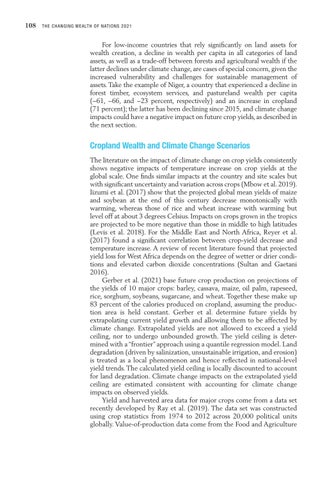108
T H E C H A N G I N G W E A LTH O F N ATIO N S 2021
For low-income countries that rely significantly on land assets for wealth creation, a decline in wealth per capita in all categories of land assets, as well as a trade-off between forests and agricultural wealth if the latter declines under climate change, are cases of special concern, given the increased vulnerability and challenges for sustainable management of assets. Take the example of Niger, a country that experienced a decline in forest timber, ecosystem services, and pastureland wealth per capita (−61, −66, and −23 percent, respectively) and an increase in cropland (71 percent); the latter has been declining since 2015, and climate change impacts could have a negative impact on future crop yields, as described in the next section.
Cropland Wealth and Climate Change Scenarios The literature on the impact of climate change on crop yields consistently shows negative impacts of temperature increase on crop yields at the global scale. One finds similar impacts at the country and site scales but with significant uncertainty and variation across crops (Mbow et al. 2019). Iizumi et al. (2017) show that the projected global mean yields of maize and soybean at the end of this century decrease monotonically with warming, whereas those of rice and wheat increase with warming but level off at about 3 degrees Celsius. Impacts on crops grown in the tropics are projected to be more negative than those in middle to high latitudes (Levis et al. 2018). For the Middle East and North Africa, Reyer et al. (2017) found a significant correlation between crop-yield decrease and temperature increase. A review of recent literature found that projected yield loss for West Africa depends on the degree of wetter or drier conditions and elevated carbon dioxide concentrations (Sultan and Gaetani 2016). Gerber et al. (2021) base future crop production on projections of the yields of 10 major crops: barley, cassava, maize, oil palm, rapeseed, rice, sorghum, soybeans, sugarcane, and wheat. Together these make up 83 percent of the calories produced on cropland, assuming the production area is held constant. Gerber et al. determine future yields by extrapolating current yield growth and allowing them to be affected by climate change. Extrapolated yields are not allowed to exceed a yield ceiling, nor to undergo unbounded growth. The yield ceiling is determined with a “frontier” approach using a quantile regression model. Land degradation (driven by salinization, unsustainable irrigation, and erosion) is treated as a local phenomenon and hence reflected in national-level yield trends. The calculated yield ceiling is locally discounted to account for land degradation. Climate change impacts on the extrapolated yield ceiling are estimated consistent with accounting for climate change impacts on observed yields. Yield and harvested area data for major crops come from a data set recently developed by Ray et al. (2019). The data set was constructed using crop statistics from 1974 to 2012 across 20,000 political units globally. Value-of-production data come from the Food and Agriculture


